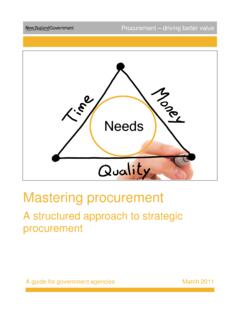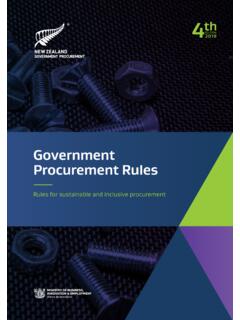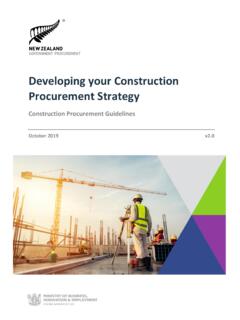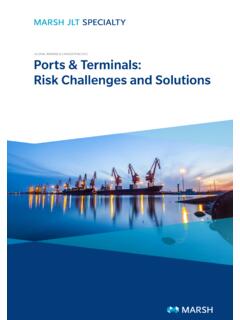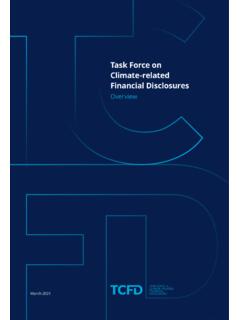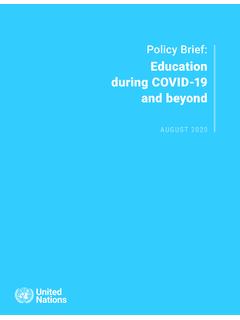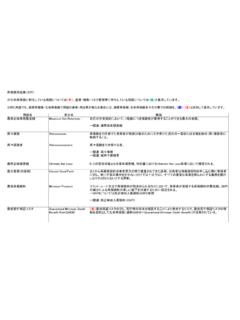Transcription of Quick guide to emergency procurement
1 Growing world-class procurement Quick guide to emergency procurement What is emergency procurement ? An emergency ' is a sudden unforseen event. It can result in injury, loss of life or critical damage to property or infrastructure. This guide outlines the procurement flexibilities that are available to agencies in an emergency situation. emergency situations can include: In deciding if an natural or manmade disasters: such as earthquakes, cyclones, tsunamis, volcanic event constitutes eruptions, flooding, fires or contamination an emergency failures of critical infrastructure or equipment: such as failure of a prison consider: security system or critical hospital infrastructure whether the critical health or environmental emergencies: such as a pandemic or food safety event falls into incident one of the categories listed political emergencies.
2 Such as a war, coup, or civil insurrection in New Zealand or or something countries where the New Zealand government offers support similar? critical security emergencies: such as a terrorist attack, serious crime or major the nature and cyber security emergency extent of harm if unanticipated events that make it impossible for an agency to perform a relief is delayed? statutory or critical function in the necessary timeframe: for example the destruction of critical election supplies immediately prior to an election would be an emergency for the Electoral Commission Urgent situations that are created by an agency through a lack of planning or risk mitigation do not constitute an emergency .
3 Agencies should consider contingency planning where appropriate to allow for the provision of goods and services if an emergency , supply shortage or other unforeseen event arises. The level of forward planning should reflect the strategic importance of the good or service, the risk of an emergency and the cost of any contingency measures. The approach taken by the agency should be balanced, practical and fiscally responsible and may be part of their wider risk management strategy. Flexibility to respond In a genuine emergency , agencies will need to be flexible in how they procure the goods and services that are required for their response.
4 Agencies are permitted to forgo routine procurement procedures. In adopting a more flexible procurement process agencies should consider what is reasonable and justifiable given all of the facts and circumstances they have to hand. Agencies are permitted to purchase direct from a supplier if the delay involved in conducting a routine procurement ( which involves advertising and competitive tendering) will prevent them delivering the goods or services in time to bring effective relief. Agencies are to balance the need to act without delay (for example to save or preserve life, or safeguard buildings or repair critical infrastructure) against meeting their overarching public sector obligations (act lawfully, reasonably and with integrity).
5 Key considerations The following key considerations may help your agency respond in an emergency : clarify that the situation meets the criteria for treatment as an emergency ' and that a flexible approach to procurement can be fully justified identify, specify and prioritise the immediate procurement activities that will bring relief consider the operating environment and conditions on the ground'. find out what other government agencies and NGOs are doing and, where possible, collaborate consider your duty of care to suppliers and take appropriate measures to ensure their safety. Maintaining accountability once the situation has been stabilised and there is no immediate risk to human life, the environment or critical infrastructure, consider establishing a governance and management structure to coordinate and authorise necessary procurement activities in emergencies there is a higher risk inflated prices ,fraud, bribery and corruption may also be a concern.
6 Be aware of these possibilities and take action to guard against them be aware of the possibility of conflicts of interest and manage them appropriately document your emergency procurements during or as soon as possible after the event clearly state in your records that the purchase was an emergency procurement and record the facts and circumstances justifying this approach. Documents must be filed in accordance with the Public Records Act 2005. whatever procurement process has been adopted it is still subject to audit for agencies subject to the Government Rules of Sourcing an exemption for emergencies is available under Rule 15.
7 However, the award of a contract over the appropriate value threshold should be published later (on the Government Electronic Tenders Service), including a clear statement that it was an emergency procurement . Types of emergencies emergency responsiveness can be viewed at three different levels with regard to the immediacy of the threat or danger and the degree of harm if relief is delayed. Level 1 Immediate response: reactive procurement Level 2 Disaster relief: emergency procurement Level 3 Post-disaster reconstruction: accelerated procurement In some emergencies, agencies will need to respond at different levels over time.
8 In other circumstances only one level of response will be required. In choosing the appropriate level of response agencies should always apply the best procurement practice possible given the circumstances and the immediacy of the need to respond. In doing so they should consider the nature and degree of the harm if relief is delayed and ensure that they can justify their procurement decisions. 2. Level 1 Immediate response: reactive procurement . When to respond In the event of a major catastrophe , it is critical to react instantly to the conditions on the ground. This may involve getting medical equipment to help the injured and This is the most securing water, food and shelter for other victims.
9 It could also involve immediately reactive level of mobilising staff, equipment or machinery or relocating service centres for major emergency response; infrastructure provision power, gas, water and telecommunication, to new safe it should be applied sites. where: In this scenario, a common sense approach to procurement must be adopted. Agency there is a threat staff will be under significant pressure to respond immediately and must be enabled to human life to do whatever is necessary and within their powers to help. Agencies are not there is a critical therefore required to follow routine procurement procedure, but simply demonstrate or catastrophic sound reasoning and good judgement when acquiring goods or services.
10 A file note threat to the should be made after the situation has stabilised covering the approach taken. natural environment or Guidance infrastructure (for obtain the necessary goods or services direct from suppliers example an oil spill), or no written contract is required where delayed ask suppliers to invoice after the situation has stabilised response would attempt to keep a note of what has been purchased be likely to deteriorate act within existing delegated authority, where possible conditions on the if there is no existing delegated authority, and no time to obtain an approval, ground or cause then exercise good judgement and be prepared to provide a rationale for the grievous harm to nature and extent of the procurement in the circumstances individuals, the environment or if a procurement involves a major expense it is recommended.
